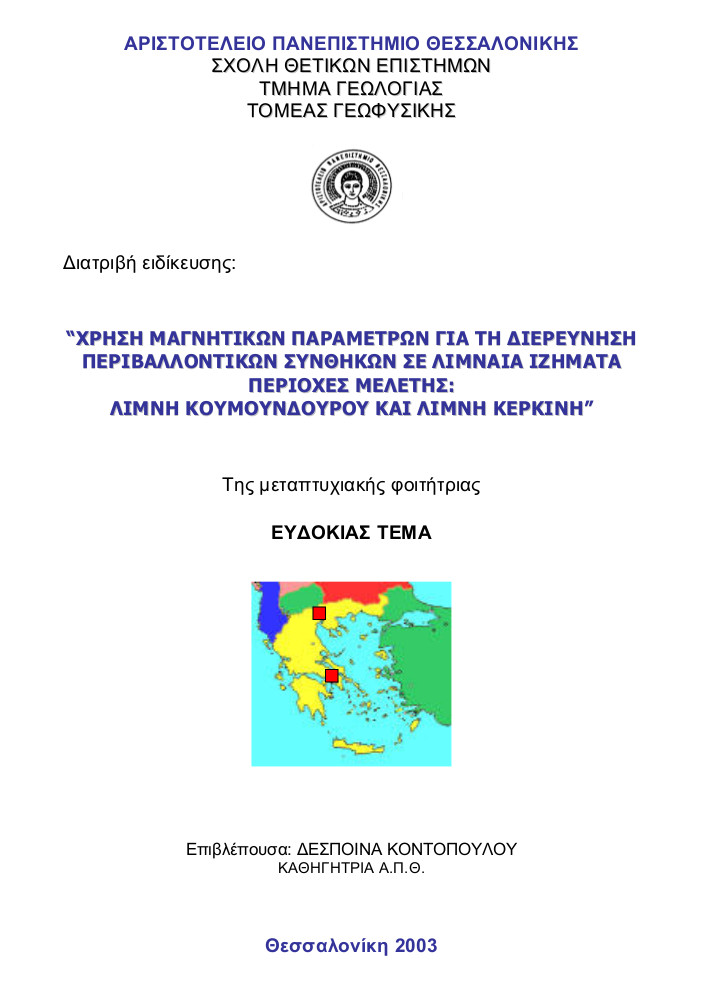
Χρήση μαγνητικών παραμέτρων για τη διερεύνηση περιβαλλοντικών συνθηκών σε λιμναία ιζήματα περιοχές μελέτης: λίμνη Κουμουνδούρου και λίμνη Κερκίνη. = Application of Magnetic methods on the investigation of the environment contitions on lake sediments a case study: Koumoundourou lake and Kerkini lake.
Περίληψη
The present master thesis deals with some aspects of environmental magnetism. Several magnetic properties present a notable correlation with magnetic mineral concentrations of anthropogenic origin and heavy metal concentrations into various environmental systems. In this way, they offer important information about heavy metal contaminated areas, magnetic minerals and anthropogenic impact into sediments. The need for rapid and inexpensive (proxy) methods that could outline areas exposed to increased pollution by particles of anthropogenic origin has drawn increased attention to the magnetic methods. This master thesis constitutes a pilot environmental magnetic study and aims to detect the anthropogenic impact into the sediments of Koumoundourou Lake (Attica) and Kerkini Lake (Northern Greece). Sediment samples were collected at three locations from Koumoundourou Lake. They have been prepared properly and their magnetic susceptibility, the frequency dependent susceptibility, the changes of magnetic susceptibility as a function of temperature and the isothermal remanent magnetization have been measured. The magnetic susceptibility profiles of the three cores have shown very small values of magnetic susceptibility. The core taken from the right bank of the lake presents the highest magnetic susceptibility values. The IRM acquisition curves show that the main magnetic mineral of the sediments is magnetite as they reveal a fast and drastic increase at weak magnetic fields. The thermomagnetic curves for core KM2-1 agree with the IRM results suggesting the presence of magnetite as the dominant magnetic mineral while the curves for the other two cores do not give much information as the magnetization of the samples is very weak to give a meaningful result. The comparison of the magnetic results with the chemical analysis of heavy metal concentrations held out at the same area (Gritzalis K. et al, 1995) is very good. It is quite probable that there is no great loading of magnetic pollution at the area investigated. Kerkini Lake is a large, artificial lake that is fed by Strymon River flowing in Greece from Bulgaria. From this lake 9 cores from 9 different sites have been taken. The magnetic susceptibility results give high magnetic susceptibility values for the first 50-80cm of the cores while at greater depths the magnetic susceptibility is much smaller and without great fluctuations. The cores G4 and G9 present the highest values and intense differentiations as a function of the depth. The IRM measurements for all cores show that magnetite is the main magnetic carrier of the sediments. For core G4 the Isothermal Remanent Magnetization has been measured for all samples and from all the different depths and the results of these measurements reveal that magnetite is the main magnetic mineral for the sediments deposited at the lake’s bottom during the last decades. Moreover, the results of the changes of magnetic susceptibility as a function of temperature give Curie temperature of about 580°C, indicative of the presence of magnetite. The increase of the magnetic susceptibility at the upper layer of the examined cores probably indicates an anthropogenic contribution on magnetic mineral concentrations possibly related with anthropogenic and industrial activities along the bank of the river.
Πλήρες Κείμενο:
PDFΕισερχόμενη Αναφορά
- Δεν υπάρχουν προς το παρόν εισερχόμενες αναφορές.
